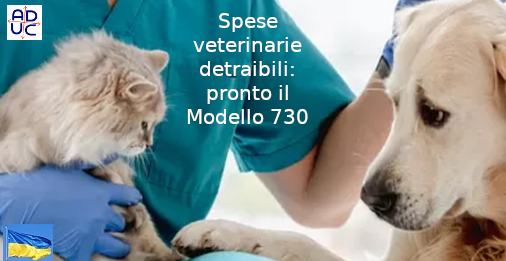There is no major news in the Model 730 of this year. The Revenue Agency has published the format that can be used in 2023 for the 2022 tax return. The 730 Model is used by natural persons and allows all expenses eligible for the discount on the due Irpef to be deducted. The Agency also publishes the instructions and the deadline: the declaration must be presented by 2 October 2023.
What veterinary expenses – The deduction is recognized for:
– expenses relating to the professional services of the veterinary surgeon
– expenses for laboratory analyzes and interventions in veterinary clinics
These are expenses incurred for the care of animals legally held for sport or for company purposes. Expenses incurred for animals kept for economic purposes (“intended for breeding, reproduction or food consumption or for the care of animals of any species bred or kept in the exercise of commercial or agricultural activities) cannot be deducted”. The Revenue Agency could request – at the time of the deduction – a self-certification attesting that the animal is legally detained for company or sporting purposes.
beneficiary – The expense can be deducted by “the person who incurred the expense, even if he is not the owner of the animal”. The ANMVI tax consultant Giovanni Stassi has already had the opportunity to specify that from the point of view of deductibility, therefore, the person to whom the pet is registered (e.g. microchip) is not relevant, but the person who claimed shopping.
Again for the purposes of the deduction – in the hypothesis that the veterinary service is requested by a subject (e.g. the wife) other than the one who bears the expense (e.g. the husband) – Dr. Stassi clarifies the situation with an example: “If the wife pays with her husband’s credit card can have the invoice made out to the husband who will be able to deduct the expense. to her”.
From 1 January 2020, veterinary expenses give the right to a tax deduction only if incurred with traceable means.
Deduction amount– The maximum ceiling of veterinary expenditure admitted to the tax deduction is 550 euros. The amount must be reduced by the deductible (134 euros) and 19% must be calculated on the difference. On balance, pet owners recover around 80 euros a year.
Veterinary expenses– Part E (Charges and expenses) Code 29 – Line from E8 to E10 – The instructions from the Revenue Agency specify that the amount to indicate in the line cannot be greater than 550 euro. The deduction will be calculated on the part that exceeds the amount of 129.11 euros. For example, for veterinary expenses incurred for a total of 600 euros, 550 euros must be indicated in the line and the 19% deduction will be calculated on an amount of 421 euros. The amount must include the disbursements indicated in the “Deductible charges” section (points from 341 to 352) of the Single Certification with tax code 29.
Veterinary expenses in the pre-filled 730– Those who present the declaration using the 730 pre-compiled by the Agency will find the veterinary expenses already indicated as transmitted by the Veterinary Doctors to the Healthcare Card System. The pet owner who accepts the pre-compiled 730 without making any changes will not be required to show the tax documents proving the deducted expenses.
Veterinary medicines- Purchases of medicines for veterinary use, with or without a prescription, in pharmacies and parapharmacies are also deductible. The benefit of the deduction does not include human food supplements, special feed for pets, even if prescribed by the veterinarian, “since they are not considered drugs, but products belonging to the food sector”.
Expenditure on medicines contributes to the maximum deductible expenditure ceiling. The data is not among those transmitted by Veterinary Doctors.
Guide dogs (Part E Line E5) – The expenses for the purchase of guide dogs are deductible. Line E5 must indicate the expense sustained by the blind for the purchase of a guide dog.
The deduction is due for the entire amount of the cost incurred but with reference to the purchase of a single dog and only once in a period
period of four years, except in cases of loss of the animal.
The deduction can be divided into four annual installments of the same amount, indicating the corresponding number in the appropriate box of the line
to the installment to be used and the entire amount of the expense incurred.
The amount to indicate in line E5 must include the expenses indicated in the “Deductible charges” section (points from 341 to 352) of the Single Certification with tax code 5
(@nmviOggi of 02/16/2023)
the association does not receives and is against public funding (also 5 per thousand)
Its economic strength are inscriptions and contributions donated by those who deem it useful
DONATE NOW
